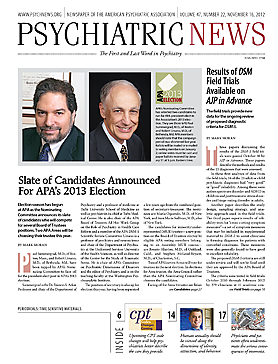People with comorbid mood and anxiety disorders have more trouble with sleep and other activities of daily life than people who have a mood or anxiety disorder alone or neither disorder, researchers at the University of California, Berkeley, have found.
Addressing insomnia complaints in people with comorbid mood and anxiety disorders may improve treatment outcomes and benefit overall functioning, Adriane Soehner, M.A., a doctoral student in clinical psychology, and Allison Harvey, Ph.D., a professor of clinical psychology, said in the October issue of Sleep.
With comorbidity of psychiatric disorders being the norm, not the exception, insomnia may maintain or exacerbate these disorders, Soehner told Psychiatric News. It also may trigger relapse.
She and Harvey analyzed data from a nationally representative cross-sectional community household survey of mental illness, the two-part National Comorbidity Survey-Replication (NCS-R).
Part 1 of the NCS-R, conducted from February 2001 to April 2003, used DSM-IV diagnostic criteria to assess mental illness in 9,282 respondents in 48 states. Part 2 reevaluated 5,692 of those individuals: everyone diagnosed with a mental illness in Part I, plus a probability subsample of Part I respondents without such a diagnosis. Part 2 of the survey included an assessment of insomnia symptoms and impairment.
Part 2 respondents included 327 people with mood disorders only, 1,137 with anxiety disorders only, 517 with comorbid mood and anxiety disorders, and 3,711 with no mood or anxiety disorder.
The mood disorders group included people with major depressive disorder, dysthymia, and bipolar disorder. The anxiety disorders group included people with panic disorder, agoraphobia, specific phobia, social phobia, generalized anxiety disorder, and posttraumatic stress disorder.
Using the NCS-R Part 2 data, Soehner and Harvey explored effects of insomnia symptoms on diverse activities of daily life.
They found that 63 percent of respondents with comorbid mood and anxiety disorders reported taking two or more hours to fall asleep, spending one or more hours awake after initially falling asleep, or awakening two or more hours earlier than desired at least once in the prior year. These respondents reported significantly more symptoms than did people in the other groups.
About 46 percent of those with either a mood or anxiety disorder alone reported at least one insomnia symptom, about double the prevalence found in people with neither disorder.
Respondents with at least one insomnia symptom in the previous year had significantly more days of impairment in many domains of daily life in the prior 30 days than did people not reporting insomnia. It was harder for them to concentrate, remember, converse, and maintain emotional control around others, for example.
These respondents indicated that insomnia also hindered their ability to accomplish usual daily activities or work, reduced the quantity or quality of these activities, and increased the effort needed to carry them out. Respondents said insomnia even interfered with basic mobility and self-care activities, including standing, walking, bathing, and dressing.
“These results,” Soehner and Harvey said, “underscore the public-health imperative to better identify and address insomnia comorbidity with the aim of reducing both societal and individual impact.”
In a second study involving nearly 5,000 workers, a team led by Victoria Shahly, Ph.D., an instructor in health care policy at Harvard Medical School, found people with insomnia more likely to report having workplace accidents and/or errors than people with 18 other common chronic physical and mental conditions.
Insomnia-related workplace accidents and errors proved significantly more costly than those attributed to other causes, $32,062 vs. $21,914, respectively, the researchers reported in the october Archives of General Psychiatry.
The costs of workplace accidents and errors commonly extend beyond the individual worker, Shahly told Psychiatric News. Equipment may be damaged. If an assembly line shuts down, coworkers lose work hours. Employers may lose revenue for products not produced or services not provided or may have to pay fines. Costs for health care and litigation add to the total.
“While there is no good systematic way to confirm indirect costs,” Shahly said, “our data suggest that 274,000 insomnia-related workplace accidents and errors occur annually in the U.S., and cost $31.1 billion.”
Shahly’s group analyzed data from the America Insomnia Survey (AIS), a national survey of insomnia in 10,094 subscribers to a large U.S. health plan, conducted in 2008 and 2009.
The researchers assessed responses by 4,991 employed or self-employed survey respondents.
This group included all those reporting any sleep problems plus an equal number of other respondents. All were assessed for 18 other chronic physical and mental conditions previously found to often be comorbid with insomnia.
The AIS asked respondents if they had had “a workplace accident that either caused damage or work disruption with a value of $500 or more” in the previous 12 months. It also asked them, “Not counting accidents, did you ever in the past 12 months make a big mistake at work that cost your company $500 or more?”
Each positive response prompted a follow-up question asking respondents to estimate “the total financial value of all the workplace accidents/mistakes you had in the last 12 months.”
About 20 percent of employed respondents reported having persistent insomnia in the previous year.
Some 4.3 percent of workers overall, and 5.5 percent of those with insomnia, reported having costly workplace accidents and errors in the previous year. Some reported having both.
Altogether, 218 respondents reported having either accidents or errors. The highest total cost the individuals estimated for one or more workplace accidents they had caused in the previous year was $100,000 and, for errors they had made, more than $1 million.
Among the 18 chronic conditions the researchers examined, however, only three had significant associations with accidents and/or errors. Emotional disorders other than major depression were associated with both accidents and errors; neuropathic pain and sleep apnea were linked to higher rates of accidents but not errors.
“Insomnia is a disorder, not just a symptom,” Shahly emphasized. “Many people with insomnia, as well as some physicians, don’t view it as a public safety risk.”
Interventions to screen for and treat insomnia in both workplaces and physicians’ offices, she noted, could reduce workplace injuries, accidents, and errors and benefit both workers and employers.

An abstract of “Prevalence and Functional Consequences of Severe Insomnia Symptoms in Mood and Anxiety Disorders: Results From a Nationally Representative Sample” is posted at www.ncbi.nlm.nih.gov/pubmed/23024435.

